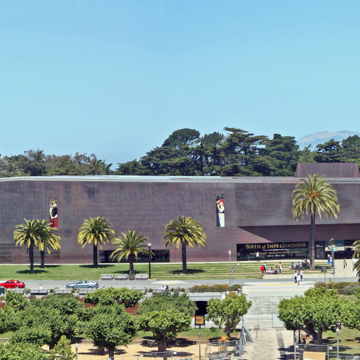The de Young Museum was founded in 1894 as part of the Midwinter International Exposition. Originally housed in an Egyptian Revival structure called the Fine Arts Building, it opened to the public as an art museum in 1895. Due to a growing audience, the first expansion of the museum took place in 1919: a new, Spanish Plateresque structure designed by Louis Christian Mulgardt. In 1921, Michael H. de Young, namesake of the museum and cofounder of the San Francisco Chronicle, further expanded upon the museum, adding a central section along with a tower, as well as a west wing in 1925. (The original Egyptian Revival building was demolished in 1929.) After the 1989 Loma Prieta earthquake severely damaged the existing museum complex, the board held a fundraising campaign and selected Swiss architects Herzog and de Meuron to design a new museum building. With its prominent tower that drew upon its predecessor’s design, the de Young Museum opened on October 15, 2002.
The long history of the museum is carried forward in the landscaping of the new facility, which features original palm trees and sphinx sculptures perched outside. Inside, the museum’s diverse collections are woven through the sprawling base of the building, conceptualized by the architects as a series of distinct pavilions linked together under one roof with interior garden atriums filling the space in between— in the architects’ words, “allowing Golden Gate Park to penetrate the museum.” To maintain this strong relationship between the museum and the park surrounding it, many of the galleries and walkways are lined with ribbon windows, keeping the park and gardens in focus alongside the art. This play between art and exterior comes to a head in the tower’s “observation floor,” where visitors encounter both a panoramic view of San Francisco and a birds-eye view of the museum, now presented as a piece of art in its own right.
The de Young Museum exists as much as a sculptural object as it does a work of architecture. Herzog and de Meuron’s blocky geometry openly speaks to the cultural forces that have shaped the museum and its collection; the museum is an obvious intervention, even as its surface—often punctuated with small holes that allow sunlight through—recalls the dappling of light that falls across the neighboring trees. This coupling of bold form and poeticized material places the de Young comfortably in a portfolio that includes buildings like Barcelona’s Museu Blau, which visitors enter sheltered under a textured stainless steel ceiling reminiscent of the reflective surface of water.
The exterior skin both sets the building apart and roots it firmly in nature. The iconic twisting tower, which tends to be central to photographs and is visible from a distance, evokes the sense of San Francisco’s skyline within Golden Gate Park. Its deep red further references the building’s proximity to the Golden Gate Bridge. In their design, the architects used 950,000 pounds of copper in the form of 7,602 panels, making the de Young the largest copper-clad building in the world. The copper, which was a bright, rusty red when installed, has come to develop a green patina over the years. Rather than the corrosive process that happens with rust, this copper patina is reflective of a deepening with age, an increased sense of the longevity of nature, and the potential longevity of architecture when it is suffused with the sophistication of nature.
References
“De Young Museum.” Herzog and de Meuron. Accessed September 11, 2018. https://www.herzogdemeuron.com/.
“History of the de Young Museum.” De Young Museum. Accessed February 14, 2017. https://deyoung.famsf.org/.
Perez, Adelyn. “M.H. de Young Museum.” ArchDaily, June 2010. http://www.archdaily.com/.
“Skin Deep.” Society for Experiential Graphic Design. November 2008. https://segd.org/.
Sudjic, Deyan. “Ructions after the quake.” The Guardian, October 30, 2005.












